Aston Martin Virage
| Aston Martin Virage/Vantage/V8 Coupe/V8 Volante LWB | |
|---|---|
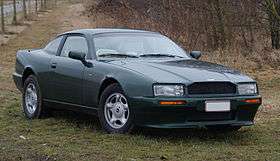 | |
| Overview | |
| Manufacturer | Aston Martin |
| Production |
1989–2000 1,050 produced 2011–2012 |
| Body and chassis | |
| Class | Grand tourer (S) |
| Layout | FR layout |
| Chronology | |
| Predecessor | Aston Martin V8 Vantage |
| Successor | Aston Martin V8 Vantage |
The Aston Martin Virage is an automobile produced by British manufacturer Aston Martin as a replacement for its V8 models. Introduced at the Birmingham Motor Show in 1988,[1] it was joined by the high-performance Vantage in 1993, and the name of the standard car was changed to V8 Coupe in 1996.
This V8-powered car was intended as the company's top model, with the 6-cylinder 1994 DB7 positioned below it. Although the DB7 was switched to a V12 engine and claimed a performance advantage, this V8 model remained the exclusive, expensive, and hand-built flagship of the Aston Martin range. It was replaced in 2000 with the Vanquish. By the end of the 2000 model year, 1,050 of all Virage related models had been produced. The V8 Vantage name reappeared on a new entry-level model in 2005.
A new generation Virage was introduced at the 2011 Geneva Motor Show, to fit into the middle of Aston Martin's current lineup.
Virage
| Virage | |
|---|---|
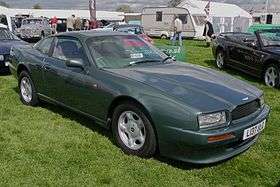 | |
| Overview | |
| Production |
1989–1995 365 produced |
| Body and chassis | |
| Body style | 2-door 2+2 coupé |
| Powertrain | |
| Engine | 5.3 L V8 |
| Transmission |
5-/6-speed manual 3-/4-speed automatic |
| Dimensions | |
| Wheelbase | 2,610 mm (102.8 in) |
| Length | 4,735 mm (186.4 in) |
| Width | 1,855 mm (73.0 in) |

When compared to the preceding V8, the design was fresh and more modern. It looked more like a Lagonda than the V8 it replaced. Indeed, the chassis was an evolution of the Lagonda's, with a de Dion tube rear suspension, located by triangulated radius rods and a Watts linkage, and a double wishbone unit at the front.[2] To cut costs, many of the less-important pieces came from other companies, as had been the case for many an Aston past. The sleek headlights and taillights were Audi 200 and Volkswagen Scirocco units, respectively, while General Motors, Jaguar, and Ford provided the steering column, climate control panel, and dash switches. In fact, Ford had purchased Aston Martin and Jaguar shortly before the Virage debuted.
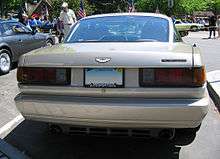
The Virage was a large, heavy car in spite of its all-aluminium body, but the 32-valve 5.3 L (5,340 cc) V8 engine's 494 N·m (364 lb·ft) torque elevated its performance to near super car levels. "Acceleration just never seems to run out", claimed Sports Car International on a first test. They also praised the "eager and quicker revving" nature of the 335 PS (246 kW; 330 hp) engine with its Callaway-designed heads and Weber-Marelli fuel injection. "Nothing sounds quite like an Aston V8," they concluded. The 1,790 kg (3,946 lb) car could reach 158 mph (254 km/h). The automatic could reach 60 mph (97 km/h) from standing in about 6.5 seconds.[1] An upgrade to 354 PS (260 kW; 349 hp) was announced at the 1996 Geneva Show.[3]
The five-speed ZF manual was fitted to about forty percent of Virages. The more popular automatic option was Chrysler's three-speed Torqueflite transmission. For 1993 the three-speed was replaced by a four-speed automatic unit.[3] The six-speed manual from the Vantage also became optional late in the Virage's production run.[4]
A less extreme V8 Coupe was also built from 1996, replacing the defunct Virage. Lacking the superchargers and the more aggressive body style of its big brother Vantage, the V8 Coupe produced 349 hp (260 kW) and 369 lb·ft (500 N·m). In total, 101 examples of the V8 version were built from 1996 through 2000.
| V8 Coupe | |
|---|---|
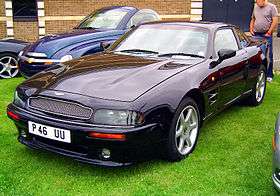 | |
| Overview | |
| Production |
1996–2000 101 produced |
| Body and chassis | |
| Body style | 2-door 2+2 coupé |
| Powertrain | |
| Engine | 5.3 L V8 |
Works Service
In January, 1992, Aston Martin introduced a conversion service, transforming the car into a Virage 6.3. As the name implies, the centerpiece of the conversion was a 6.3 L (6,347 cc) V8 derived from the AMR1 racing car. This engine produced 500 hp (373 kW) at 6,000 rpm and 480 lb·ft (651 N·m) at 5,800 rpm, allowing the car to reach 175 mph (282 km/h).
Other changes included 362 mm (14 in) ventilated disc brakes, the largest used in a passenger car until the Bentley Continental GT, and 18 in (457 mm) wheels. Visually, the 6.3 had wide flared bumpers, low sills and air dams, and side air vents.
- Virage Shooting Brake
In true British tradition, a shooting brake (estate) version of the Virage was offered in extremely limited numbers. A three-door four-seater, it debuted at the March 1992 Geneva Motor Show. Unlike prior Aston Shooting Brakes, however, the Virage was produced in-house by the company's Works Service, with maybe six constructed in total. The price new was GB£165,000. The cars are believed to have retained Virage chassis numbers, except two that received chassis numbers of the type "DP/2099".[5]
- Lagonda Virage Saloon
Another rare Works Service car is the Lagonda Saloon. Only a handful of these long-wheelbase four-door Virages were built as a special customer order, reviving Aston Martin's long-dormant second marque. Introduced in 1994, it was made by Aston Martin Works Service with a 12-inch (30 cm) chassis extension, although two were ordered with an 18-inch (460 mm) extension. The name refers to the four-door Aston Martin Lagonda. The Lagonda Virage cost about GB£250,000 and only eight or nine were made, with some being conversions of regular Virages.
- Lagonda Virage Shooting Brake
The five-door Lagonda Virage Shooting Brake debuted at the same time as the Lagonda Virage. It was made by Aston Martin Works Service in only one or two examples, and has been spotted bearing "Vacances" badging at the rear.
Virage Volante
| Virage Volante | |
|---|---|
 | |
| Overview | |
| Production |
1992–1996 233 produced |
| Body and chassis | |
| Body style | 2-door 2+2 convertible |
| Powertrain | |
| Engine | 5.3 L V8 |
The Virage Volante convertible debuted at the 1990 Birmingham Motor Show as a strict two-seater, but a 2+2 version was shown at the 1991 Geneva Motor Show.[1] Production examples, beginning in 1992, were all to feature 2+2 seating. Sources claim that between 224 and 233 examples had been produced when the series ended in 1996. The last 11 example (hence the difference between 224 to 233) already had the naturally aspirated 1995 version motor of the later V8 and V8 LWB Volante with the improved four-speed and overdrive Torqueflite automatic and 354 hp (264 kW).
A new V8 Volante Long Wheelbase, with styling based on the V8 Coupe was built from 1997 to 2000 on a lengthened chassis. 63 V8 Volante LWB cars were built.

| V8 Volante Long Wheelbase | |
|---|---|
| Overview | |
| Production |
1997–2000 63 produced |
| Body and chassis | |
| Body style | 2-door 2+2 convertible |
| Powertrain | |
| Engine | 5.3 L V8 |
The final Virage variant to be built was the ultra-limited V8 Vantage Volante of 2000. Nine of these high-performance convertibles were produced, one of them on the long wheelbase chassis.
Vantage
| Vantage/Le Mans | |
|---|---|
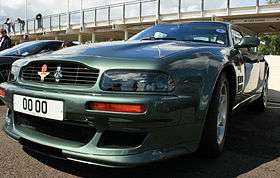 | |
| Overview | |
| Production |
1993–2000: 280 produced Volante, 2000: 8 SWB, 1 LWB |
| Body and chassis | |
| Body style |
2-door 2+2 coupé 2-door 2+2 convertible |
| Powertrain | |
| Engine | 5.3 L supercharged V8 |
As with many other Astons, a high-performance Vantage model of the Virage would later appear. First shown at Birmingham in September 1992, the Vantage was produced from 1993 through 2000 and, like so many other Aston Vantages, soon became the only variant available. Indeed, the Virage name lasted just a few years, with its final descendants inheriting the simple and familiar V8 name.
The design was freshened, leaving only the roof and doors of the car intact. The Vantage was wider, appeared lower, and used four round tail lights (rumoured to have been those used on a Bova coach for the prototype). Like the 6.3, the Vantage used record-sized 362 mm (14 in) brake discs and 18 inch wheels.[4]
The most radical change to the Vantage, however, was inside the engine compartment. The 5.3 L engine now sported twin superchargers. Power output topped the industry at 550 hp (410 kW), and torque was equally impressive at 555 lb·ft (745 N·m) at 4,000 rpm. Top speed was 300 km/h (186 mph), with a dash to 60 mph (97 km/h) taking just 4.6 seconds.[4] Considering that the kerb weight of the car was almost two tons, this was no mean feat. The engine was later uprated to 600 hp (447 kW) for the 1998 V600. The earlier version is often referred to as "V550" to set it apart from the later, upgraded ones.
In 2000, Aston Martin's "Works Service" unit built nine bespoke Vantage Volantes (convertibles), one of which was built to long wheelbase specifications.
V8 Vantage Le Mans
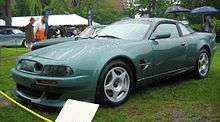
Just before the new European emission and safety regulations came in force, Aston Martin decided to put a memorable end to the V8-Vantage line with a special model called "V8 Vantage Le Mans". Honoring Aston Martin's 1959 victory at the 24 Hours of Le Mans, the prototype of a limited run of 40 was presented in Geneva in 1999 on the 40th anniversary of the win. They were the only Aston Martin to carry the Le Mans name.
The engine delivers 612 PS (450 kW; 604 hp) and 820 N·m (600 lb·ft) of torque, supported by a suspension reinforced with special Koni shock-absorbers and stiffer anti-roll bars. The bodywork featured a blanked-out front grille and modified side vents – replicating the side vents of the Le Mans winning DBR-1 – as well as a bigger front spoiler and rear skirt. The interior was reworked with a gigantic rev-counter, a special Titanium finish on some parts, and features such as heated windshield, parking radars, traction control, heated electric seats, and full Connolly leather upholstery with matching Wilton wool carpets. Wheels were the same Dymag magnesium units as seen on most V600s. Performance included a claimed top speed of 200 mph (or 320 km/h) and zero to 100 km/h in 3.9 seconds. The keyholder was in sterling silver and a map from Newport-Pagnell to the legendary Le Mans track was provided in the delivery documents. Each car was made upon special commission and fitted with a number plate indicating also the name of the first owner.
U.S. availability
The Virage did not become available in the United States until the summer of 1990 and the Virage Volante convertible would become available in 1992. Shooting Brake versions and the Virage Vantage were not officially offered for sale in the U.S. The car's availability ended after the 1993 model year, due to the lack of passenger airbags and inability to meet emissions regulations.[6]
Virage (2011–2012)
| Virage | |
|---|---|
 | |
| Overview | |
| Production | 2011–2012 |
| Body and chassis | |
| Body style | 2-door 2+2 coupé or convertible (Volante) |
| Related |
Aston Martin DB9 Aston Martin DBS |
| Powertrain | |
| Engine | 5.9 L V12 |
In February 2011 it was revealed that a new Aston Martin Virage would be launched at the Geneva Motor Show. Based on the DB9, the Virage was intended to sit in the narrow slot between the basic version and the flagship DBS.
It has a 2-seat or 2+2 seating configuration. Virage's hand-assembled 6.0-litre V12 engine delivers 490 hp (365 kW) and torque of 570 Nm. It is capable of doing 0 to 100 km/h in under five seconds. The Virage was available in two versions: Coupé or Volante (convertible).[7][8]
In series 17, episode 2 of Top Gear, James May said that the Virage is the "in-the-middle" version that was sharper than the DB9 but not as aggressive as the DBS. However, he was unhappy that the Virage is just "another pointless bone-shaking racing car",[9] and made many complaints about the ride comfort, stating that its lack of comfort was a direct result of it having been tested at the Nürburgring, because too much emphasis was put on handling, and too little effort was put on comfort. It set a lap time of 1:24.4 at the Top Gear Test Track.
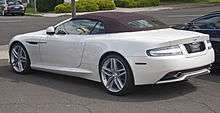
Aston Martin has announced that the current Virage would be discontinued after 18 months of production, as the distinctions between it, the DB9, and the DBS were simply too slim.[10]
References
- 1 2 3 Büschi, Hans-Ulrich, ed. (March 1991). Automobil Revue 1991 (in German and French). 86. Berne, Switzerland: Hallwag AG. p. 163. ISBN 3-444-00514-8.
- ↑ Autocar & Motor, Aug. 15, 1990, p. 29.
- 1 2 Büschi, Hans-Ulrich, ed. (6 March 1997). Automobil Revue 1997 (in German and French). 92. Berne, Switzerland: Hallwag AG. p. 151. ISBN 3-444-10479-0.
- 1 2 3 Automobil Revue 1997, p. 153
- ↑ "Virage Shooting Brake in Aston Martins.com". AstonMartins.com. Retrieved 2015-03-21.
- ↑ Mateja, Jim (22 June 1997). "DB7 is a shout from long-hushed Aston Martin". Chicago Tribune.
- ↑ Steve Cropley (23 February 2011). "Aston brings back the Virage". Autocar.co.uk. Retrieved 23 February 2011.
- ↑ Chris Knapman (23 February 2011). "Aston Martin brings back the Virage". The Telegraph. Archived from the original on 10 March 2011. Retrieved 23 February 2011.
- ↑ "Aston Martin Virage test (Series 17, Episode 2) - BBC Top Gear". Archived from the original on 8 December 2011.
- ↑ Ramsey, Jonathon (2012-09-04). "Aston Martin Virage discontinued after short lifespan". AutoBlog.com. Retrieved 2012-09-19.
- 1. Kevin Blick (September 1990). "Anglophyle Style". Sports Car International. 6.9: 22–27.
- 2. Covello, Mike, updated by, Standard Catalog of Imported Cars: 1946–2002, Krause Publications, Iola, WI, U.S.A., 2002.
External links
| Aston Martin Lagonda road car timeline, 1948–present | ||||||||||||||||||||||||||||||||||||||||||||||||||||||||||||||||||||||
|---|---|---|---|---|---|---|---|---|---|---|---|---|---|---|---|---|---|---|---|---|---|---|---|---|---|---|---|---|---|---|---|---|---|---|---|---|---|---|---|---|---|---|---|---|---|---|---|---|---|---|---|---|---|---|---|---|---|---|---|---|---|---|---|---|---|---|---|---|---|---|
| Type | 1940s | 1950s | 1960s | 1970s | 1980s | 1990s | 2000s | 2010s | ||||||||||||||||||||||||||||||||||||||||||||||||||||||||||||||
| 8 | 9 | 0 | 1 | 2 | 3 | 4 | 5 | 6 | 7 | 8 | 9 | 0 | 1 | 2 | 3 | 4 | 5 | 6 | 7 | 8 | 9 | 0 | 1 | 2 | 3 | 4 | 5 | 6 | 7 | 8 | 9 | 0 | 1 | 2 | 3 | 4 | 5 | 6 | 7 | 8 | 9 | 0 | 1 | 2 | 3 | 4 | 5 | 6 | 7 | 8 | 9 | 0 | 1 | 2 | 3 | 4 | 5 | 6 | 7 | 8 | 9 | 0 | 1 | 2 | 3 | 4 | 5 | 6 | 7 | |
| Owner | David Brown | William Wilson | Minden & Sprague | Victor Gauntlett et al. | Ford | Independent Consortium | ||||||||||||||||||||||||||||||||||||||||||||||||||||||||||||||||
| City Car | Cygnet | |||||||||||||||||||||||||||||||||||||||||||||||||||||||||||||||||||||
| Luxury Car | Rapide | |||||||||||||||||||||||||||||||||||||||||||||||||||||||||||||||||||||
| 2.6 ltr | 3 ltr | Rapide | Lagonda | Taraf | ||||||||||||||||||||||||||||||||||||||||||||||||||||||||||||||||||
| Grand Tourer | DB4 | DB5 & Volante | DBS & Vantage | DB7 | Vantage | |||||||||||||||||||||||||||||||||||||||||||||||||||||||||||||||||
| DB1 | DB2 | DB2/4 & MKIII | DB6 | DBS V8 & AM V8 | V8 Virage | V8 | DB9 & V12 Virage | DB11 | ||||||||||||||||||||||||||||||||||||||||||||||||||||||||||||||
| V8 Vantage | V8 Vantage | Vanquish | DBS V12 | Vanquish | ||||||||||||||||||||||||||||||||||||||||||||||||||||||||||||||||||
| Limited Production | One-77 | Vulcan | ||||||||||||||||||||||||||||||||||||||||||||||||||||||||||||||||||||
| DB4 Zagato | V8 Zagato | DB7 Zagato | DB AR1 | V12 Zagato | ||||||||||||||||||||||||||||||||||||||||||||||||||||||||||||||||||
| Concept Car | ||||||||||||||||||||||||||||||||||||||||||||||||||||||||||||||||||||||
| Color code |
Aston Martin badge Lagonda badge | |||||||||||||||||||||||||||||||||||||||||||||||||||||||||||||||||||||
